
Crowds gather in the Market Place
for the 1914 Wednesbury and District Co-Operative
Society Gala. From an old postcard. |
| Some shops and businesses
in the early 20th century
Wednesbury town centre had a wide variety of shops, selling
all kinds of products, foodstuffs, and offering a
considerable range of services. It is hardly surprising that
it became popular with the local population, especially as
the town had an excellent market, and was well served by the
South Staffordshire Tramways Company Limited.
What follows is a brief description of
some of the well-known shops and businesses that thrived in
the town during the first quarter of the twentieth century.
E. P. Brown & Company Limited, 13
Market Place
|
|
The shop, which stood on the corner of
Union Street and Market Place first opened for business in
the mid 1860s. It was originally run by Mr. L. B. Longmore,
and later by his son, Mr. F. V. Longmore.
Mr. Brown, who
took the business over around 1912 was a gentleman’s
outfitter and specialised in hats, socks, woollen items,
shirts, and gloves.
The shop had three large display
windows, and was popular with the local male population.
Other stocked items included silk and felt hats in the
latest styles, panama, and soft hats, juvenile caps of every
description, good class hosiery and underwear, ties,
scarves, collars, and cuffs etc. Shirts were made to
measure, with the guarantee of a perfect fit.
Browns were
agents for Dr. Jaeger's pure wool underwear, and Aertex
cellular clothing. Items were always economically priced. |
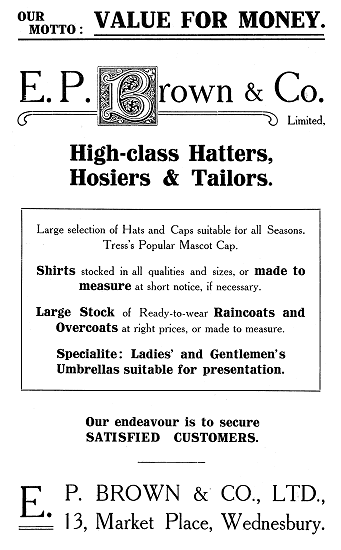
An advert from 1916. |
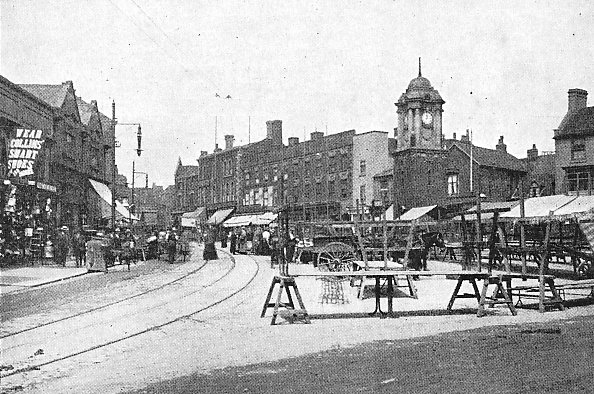
The Market Place in 1915.
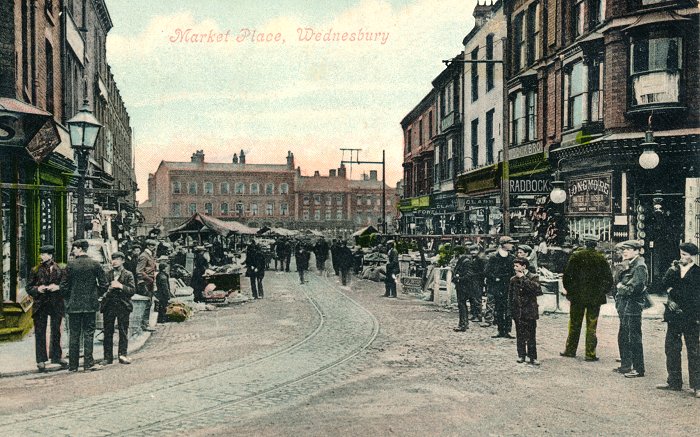
A fine view of the Market Place in the early
1900s. From an old postcard.
|
W. Charles, Coal, Coke, and Haulage
Contractor, Bridge Wharf, and Darlaston Road, Kings Hill
|
|
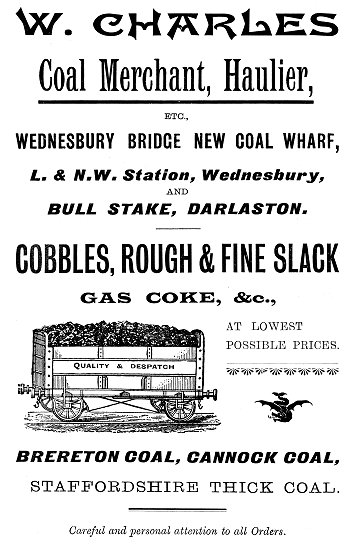
An advert from 1905. |
A very old established coal and coke
supplier, founded by Mr. W. Charles in 1879, and later run
by his son, Mr. Frank Charles.
The business had a high
reputation and absorbed a large share of the trade in the
district. All kinds of best household coal was supplied in
cart or truck loads, and manufacturers were supplied with
furnace, steam and other coals, and coke, or slack etc.
Mr. Charles was the sole agent in the
district for Brereton coal, and all kinds of Cannock, South
Warwickshire and South Staffordshire products.
General
haulage contracts were undertaken, and an adequate number of
light or heavy vehicles were available for the purpose. |
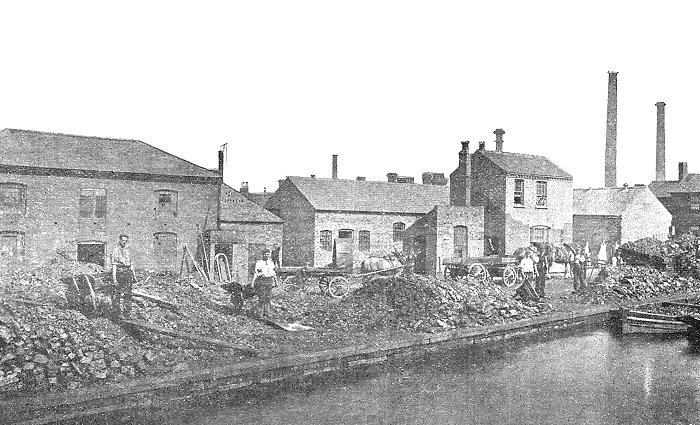
W. Charles' Wednesbury Bridge coal wharf.
|
Arthur H. Coney, Ladies and Gents
Tailor, 30, Lower High Street
Mr. Arthur H. Coney founded the
business in 1903. The shop had a large display window, and
contained a large amount of stock, and several workrooms.
Mr. Coney was an accomplished tailor,
who used the newest and most fashionable patterns.
He catered for both ladies and
gentlemen, and guaranteed a perfect fit, and superior finish
for each garment.
He specialised in the making of
breeches, and offered competitive prices. His aim was to
give complete satisfaction to each customer. |
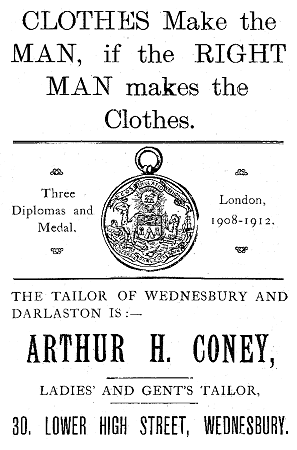
An advert from 1922. |
|
S. Hickinbottom, Baker and
Confectioner, Electric Bakery, Victoria Street
Mr. S. Hickinbottom was well known for
the high quality products produced at the Electric Bakery,
which were unsurpassed for purity, sweetness, and
digestibility. The business was founded in the late 1890s in
Lower High Street, and moved to Victoria Street in 1905. The
bakery was equipped with the most modern and up-to-date
machines and plant to ensure a high standard of quality. Mr.
Hickinbottom conclusively proved that machine-made bread
could be produced to rival the best homemade varieties. He
also made all kinds of cakes, scones, buns, pork pies and
general confectionery, which were described as unsurpassed
dietetic dainties. His carts and vans delivered daily
throughout the town and the surrounding districts. His
products were widely recommended, and sales steadily
increased.
|
|
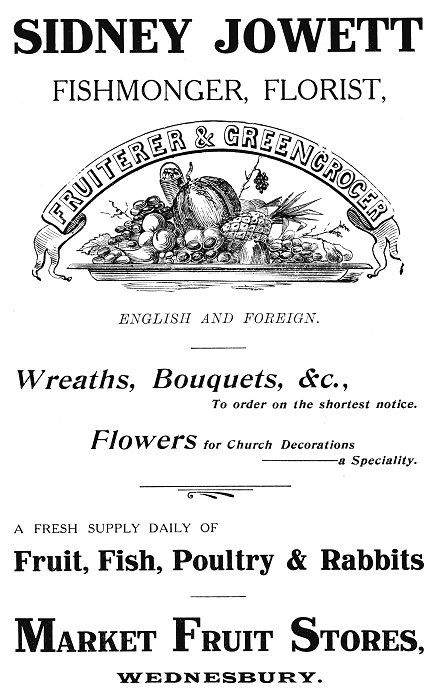
An advert from 1909. |
Sidney Jowett, Florist, Fruiterer,
Fish and Poultry Dealer, Market Place
This popular business was founded
around 1904. Sidney Jowett was regarded as one of the most
reliable and enterprising representatives of the trade to be
found anywhere.
He was known for offering only the most
reliable and best quality goods at the lowest possible
prices, ensured by his exceptional purchasing facilities in
the best markets, and a large turnover.
The premises was
known as Market Stores and supplied all kinds of fruit in
season, fish, poultry, rabbits and flowers. Jowetts
specialised in the making of wreaths, crosses, bouquets,
gent's button holes and ladies sprays.
|
|
M. &. J. Lillis, Ladies' Outfitters,
Lower High Street
The shop of Misses M. & J. Lillis was
one of the most popular and important business concerns in
Wednesbury. It began trading in 1859 and occupied a
prominent position in Lower High Street. It became very
popular with lady residents of the town and surrounding
districts, and continually featured attractive displays in
the shop windows.
A range of fashionable and first class
stock was always available, including a wide variety of baby
linen, and shawls, and specialities such as ladies blouses,
corsets, laces, gloves, umbrellas, hosiery, aprons,
neckwear, and underwear. All the usual lines in haberdashery
and fancy drapery were stocked, and the business gained a
high reputation for its quality items. |
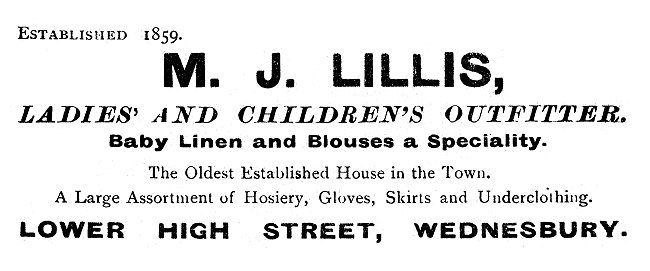
An advert from 1922.
| W. A. Page, Wholesale and Retail
Tobacconist, Market Place and Upper High Street |
|
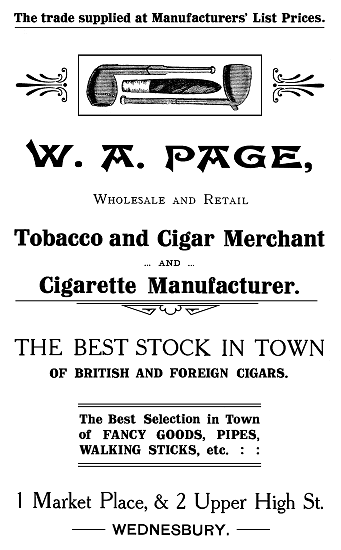
An advert from 1917. |
Mr. W. A. Page had an extensive
business in both the wholesale and retail tobacconist trade.
He started in Upper High Street in 1905, and opened a second
shop in Market Place in 1910.
He stocked all the leading
brands of tobacco, cigars, and cigarettes, and all makes and
kinds of pipes, cigar and cigarette holders.
He also
supplied pouches, cigar, and cigarette cases, and a wide
range of smokers' accessories.
He supplied publicans and
shopkeepers throughout the area, and was known to be very
reliable. |
|
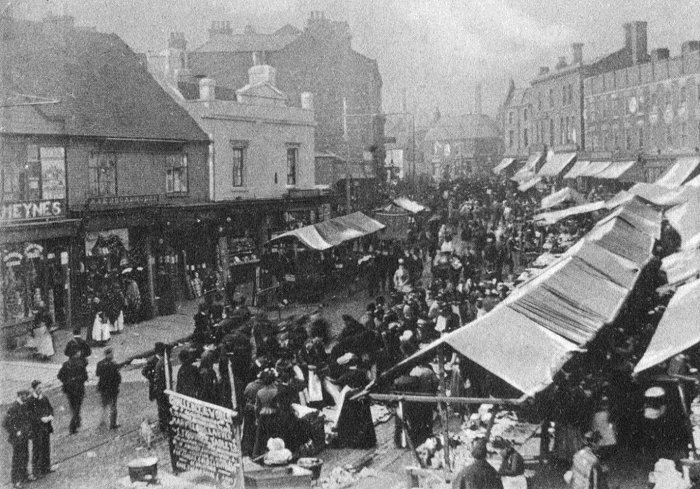
The Market Place. From an old
postcard. |
|
George Powell, Tailor, Clothier,
Hatter and Hosier, 18 to 19 Market Place, Wednesbury, and 49
to 50 King Street, Darlaston
Both shops were established in the mid
1880s and later acquired by Mr. Powell, who had gained a lot
of experience in the trade. Both shops had a good frontage,
and carried a large stock of ready to wear clothing. It was
usually possible to find something to fit every customer,
ranging from moleskin or hard wearing clothes, to best wear.
A large trade was done in boy's school and best suits in all
sizes, for all ages. The tailoring department was noted for
the style, fit, and finish of all garments made to measure,
and the lowest possible prices were charged. A fine range of
patterns, of all the newest materials and fashionable shades
was on hand, and the best workmanship and most careful
attention to detail was always carried out. Hats of all
kinds and of the latest fashions and shapes, together with
caps, shirts, pants, hosiery, neckwear, and all articles of
gents outfitting were on offer. Mr. Powell was chairman of
the Wednesbury Tradesmen's Association.
S. R. Poxon, 20 and 21, Lower High
Street
|
|
Mr. Poxon's business occupied a
prominent position in Lower High Street and carried a
comprehensive stock of household furniture and furnishings,
the widest selection available in the town.
The business was
founded in the late 1890s and had large show windows and
showrooms.
The staff included extremely
experienced upholsterers, cabinet makers, and repairers who
worked under Mr. Poxon’s personal supervision.
A good stock
of floor coverings, carpets, and linos were available, all
at very reasonable prices.
Mr. Poxon also stocked wringers,
mail carts, pianos, and antique furniture. He purchased
second-hand furniture and had an exchange scheme for any
kind of furniture.
|
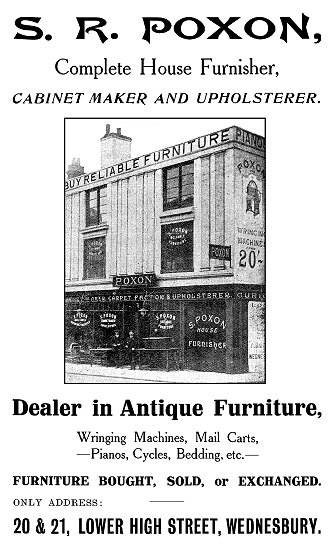
An advert from 1912. |
| F. W. Preece, Draper and House
Furnisher, Market Place |
|
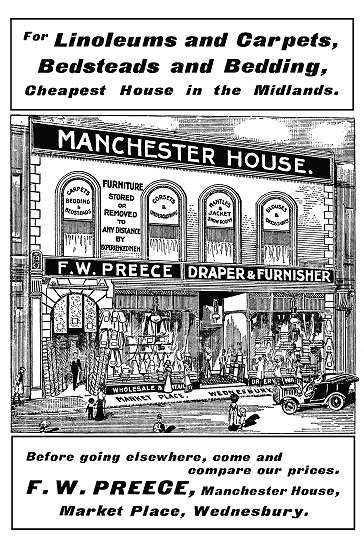
An advert from 1917. |
The large and popular drapery and
furnishing establishment of Mr. F. W. Preece occupied a good
central position in the Market Place.
It is an old business,
founded in the early 19th century by the Dawes family, who
ran it for around 100 years.
Mr Preece took control in 1904
and extended and altered the premises to meet a great
increase in business.
The spacious shop had a large window,
with stock, and showrooms on the upper floors above. Stock
included general furnishing, linen and fancy drapery, ladies
dresses, skirts and blouses, material, outfitting goods and
hosiery for ladies, girls and children, lace, trimmings,
silk and satins etc.
Furniture included beds, carpets, lino,
oilcloths, rugs, curtains, blinds, and drapery etc.
The
management prided itself on a prompt and polite service,
offered to all customers. |
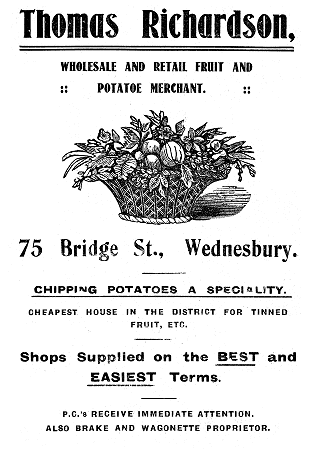 |
|
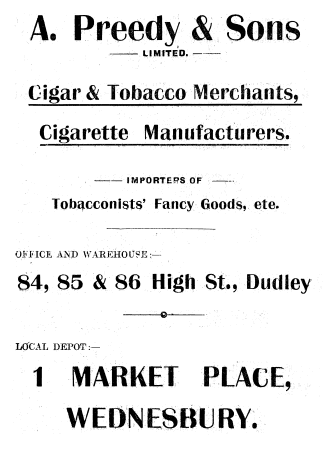 |
|
Two adverts
from 1922. |
|
|
Mr. A. Strickley, Family Grocer &
Provision Merchant, Oakeswell, Walsall Road
Mr. A. Strickley was known as one of
the most reliable grocers in the area. He founded his
business in 1880 in the well positioned corner premises with
good display windows, and ample room for storage. He stocked
a wide range of items, all of the highest quality, including
ham, bacon, butter, tinned and bottled specialities, tea,
and Italian warehouse goods. Every Christmas a very fine
show was made of seasonable goods, and crackers, etc. Orders
were regularly called for, and delivered in Wednesbury and
the surrounding area. Mr. Strickley had been in the business
all his life, and had previously worked at some of the
largest firms in Birmingham and the district.
S. Webb, Funeral Undertaker and
Carriage Master, New Central Mews and Taxi Garage, Upper
High Street, Wednesbury, and 41 King Street, Darlaston
|
|
Mr. Sidney Webb was well known as an
undertaker throughout much of South Staffordshire.
The
business, which was one of the best organised and most
popular, was founded in the mid 1890s, and moved to Upper
High Street around 1900.
The premises, which is still in use
today, was very extensive for the time, and had a showroom
at the front, and a large mews and taxi garage at the rear.
Sidney Webb owned first class horse-drawn hearses, a motor
hearse, and a good number of new and excellently upholstered
horse-drawn funeral carriages.
He carried out funerals in
their entirety, in any part of the district, and gained a
reputation for moderate charges and carefully planned
arrangements.
He ran his taxi garage on up-to-date lines,
and owned a number of well appointed cars for hire, both
during the day, and at night. |
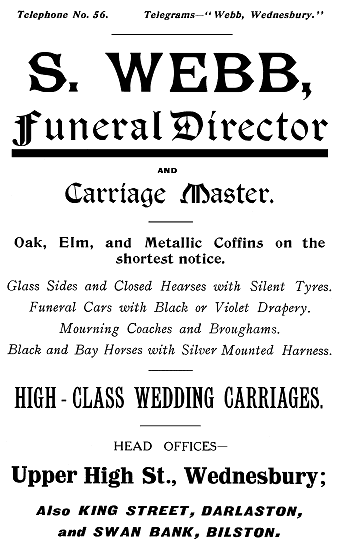
An advert from 1909. |
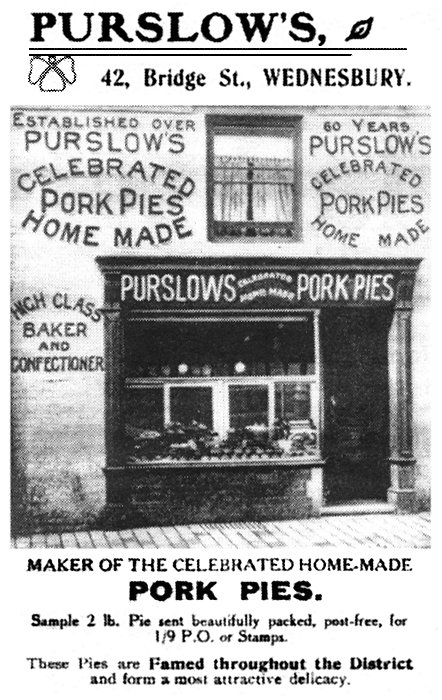
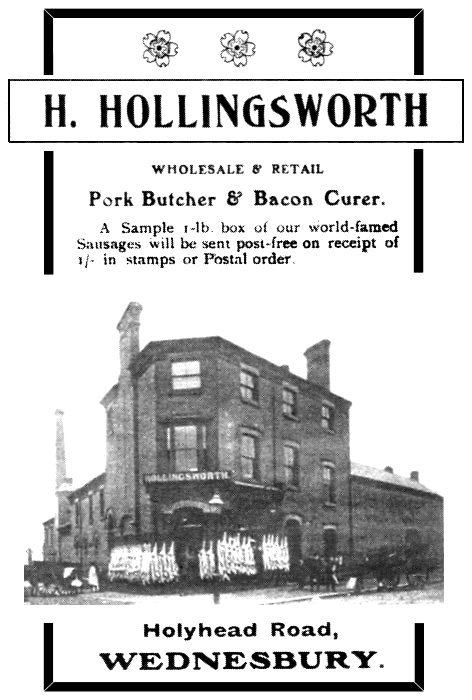
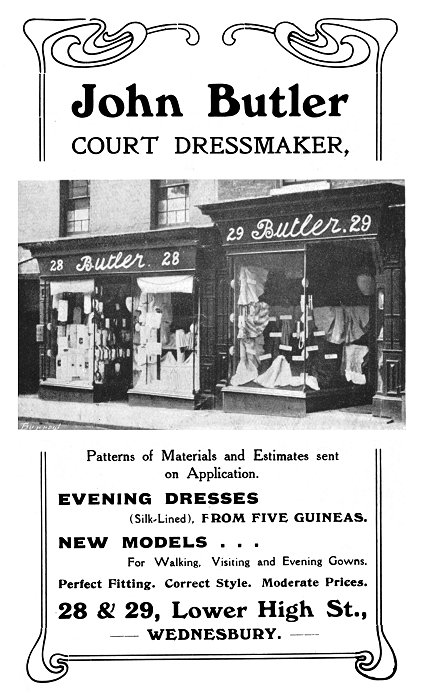
An advert from 1908.
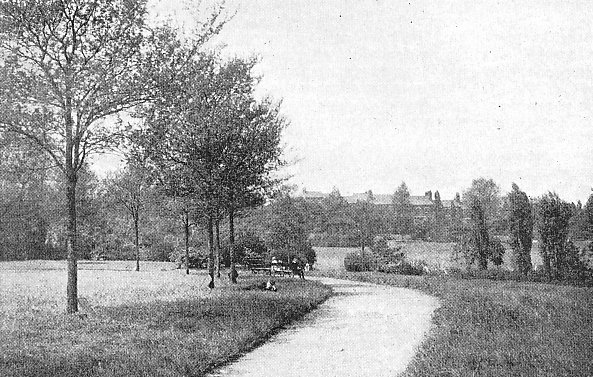
Brunswick Park in 1915.
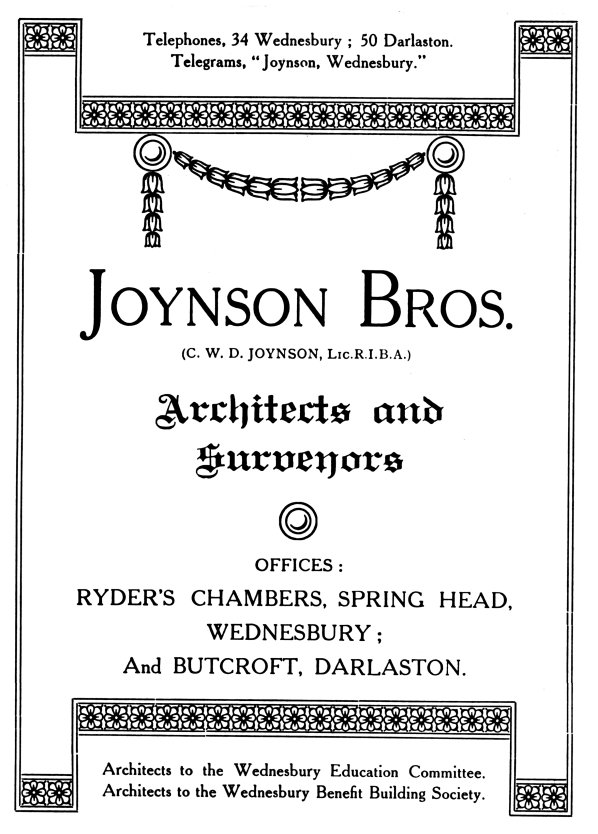
An advert from 1917.
| Theatres and Cinemas
The Old Theatre Royal in Earps Lane
opened in 1860. It closed in 1883 and was purchased for use
as a citadel by the Salvation Army. In 1905 they
moved to a new citadel in Upper High Street and opened a
second barracks in Crankhall Lane.
In 1909 the theatre
reopened as the King’s Hall, a variety theatre and cinema
which would have a checkered career. After renovation in the
1920s, it reopened again, this time as the Rialto Cinema.
After the reopening in October 1927 it had a short life,
remaining in business for just over three years. Yet again
the building was renovated, and extended, and the facilities
were improved. After reopening in September 1931 it would
again have a short life. This time it survived for around
six years, to be renovated yet again, with the addition of a
new imposing front to the building.
After reopening in August 1938 it had its longest unbroken
run as a cinema, eventually closing in April 1957 as a
result of declining audiences. After redecoration it
reopened yet again in November 1958, and continued in use as
a cinema until July 1961 when it became a bingo club. It
remained in business until about 1970 when it finally
closed. At the time the area around the High Bullen was
being redeveloped and the new dual carriageway built. The
building finally met its end in 1973 as part of the
redevelopment.
In 1891 the New Theatre Royal opened in
Upper High Street. It was designed by local architect C. W.
D. Joynson and seated 800 people as follows:
|
Orchestra Stalls (tip-up seats)
|
149 |
| Pit
Stalls |
314 |
|
Pit |
110 |
|
Centre Circle (tip-up seats)
|
151 |
|
Side Circle |
72 |
| Two
Private Boxes |
4 |
|
Total
|
800 |
|
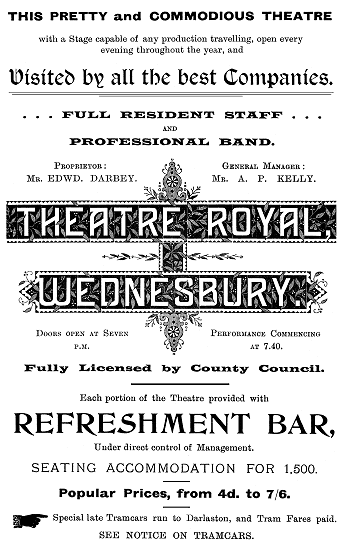
An advert from 1897. |
It had a parquet
floor, an orchestra enclosure, licensed bars, a bill room,
stores, and manager’s office. In the early years of the
twentieth century Professor Joseph Wood and his son Thomas
began to visit the theatre with their travelling film show.
The films were shown between variety acts. It became the
Hippodrome in 1910 and a cinema box with two projectors was
installed at the back of the circle.
It was later owned
by local businessman Hubert John Barlow, of H. J. Barlow &
Company, a nut and bolt manufacturer at Mounts Road Works in
Bridge Street. He became Mayor of Wednesbury in 1931, and
ran H. J. Barlow’s Repertory Company. During World War 2 the
theatre was used as a British Restaurant.
In the 1950s films
were shown at the beginning of the week, followed by plays
and productions at the end of the week.
The Hippodrome
closed for the last time in April 1959 and was demolished in
the 1960s. |
Tony Walker has an
amusing recollection about the Hippodrome from the 1950s:
"My parents took
me there in about 1953 from nearby Walsall, my mother came
from Wednesbury. It was a general variety show but part of
the way through, a lady said 'I now have some poses for
you'. She certainly had, the curtains closed and reopened
and there she was, starkers, kneeling down with an elaborate
candlestick in each hand held aloft. She did several other
poses but I don't think my embarrassed parents knew what to
say."
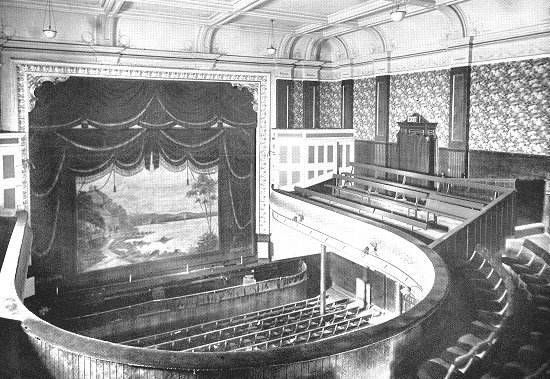
The Hippodrome stage.
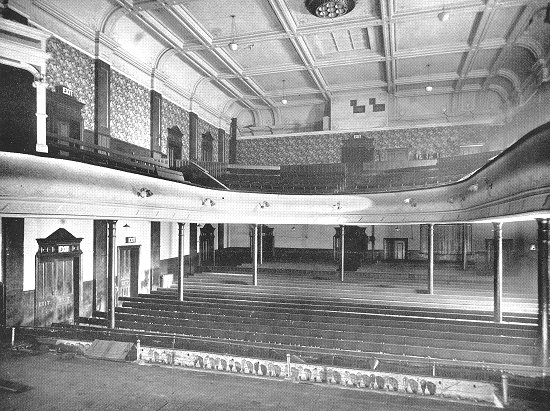
The Hippodrome auditorium.
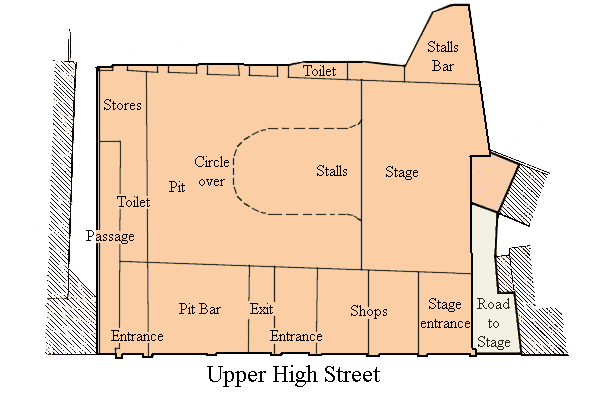
The Hippodrome.
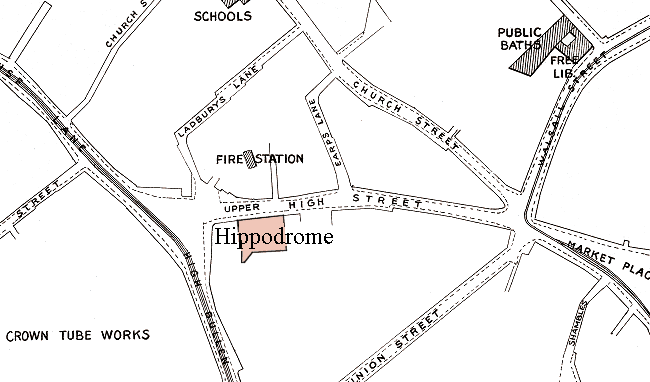
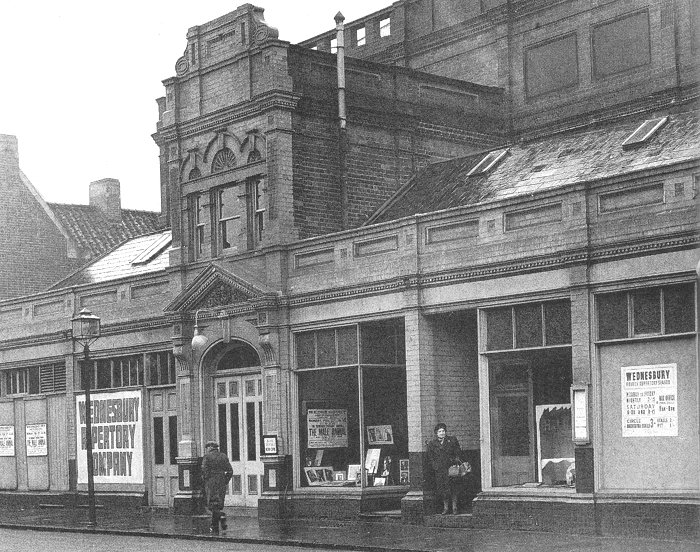
The Hippodrome in 1950.
A second cinema
opened in Upper High Street on Monday 7th October, 1912 called the
Imperial Picture Palace. The cinema, run by the Wednesbury
Imperial Picture Company became known as 'The Imperial' and
also 'The Palace'. Like the Hippodrome it was designed
by C. W. D. Joynson. The cinema had an elegant facade, a
carpeted floor, and tip-up seats which were arranged so that
everyone in the audience had an unobstructed view of the
screen. The opening films were
'The Man of the Wilds', and 'Relief of Lucknow'.
1931 saw the
introduction of sound, a full two years after the talkies
came to The Picture House, and a year after sound equipment
had been installed at The Rialto. The cinema remained in business until
May 1937 after which it was extensively modernised and
extended to accommodate 1,200 people. It reopened on
27th September, 1937 and was quite successful until
audiences started to decline in the 1950s. It became a bingo
hall in the first few months of 1961, but closed in December
of that year, and was demolished in 1964.
Another cinema, the
only one of the old cinemas to still survive, opened as The
Picture House, in Walsall Street on 25th March, 1915. It
remained in business until January 1938 when it closed, and
was rebuilt as a modern, state of the art cinema
accommodating 1594 people. The new cinema, now called the
Gaumont, opened in October 1938 and was a great success. On
9th March, 1964 it became the Odeon and continued to be
successful for several years.
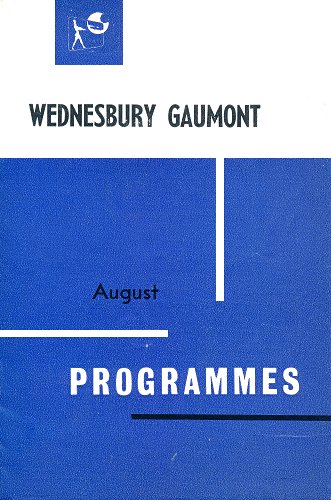 |
|
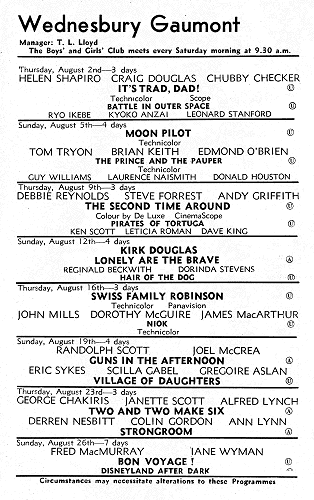 |
|
A
programme from 1962. |
|
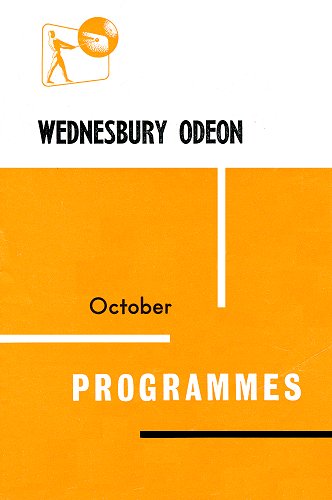 |
|
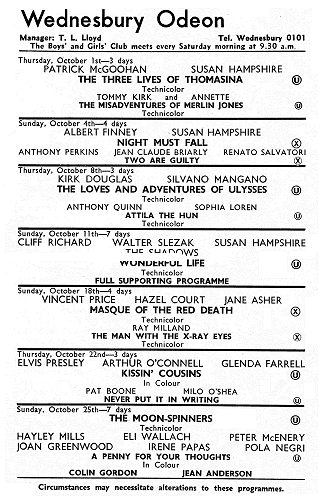 |
|
A
programme from 1964. |
|
In January 1972 the
cinema was acquired by the Silver Cinema Company Limited to
show English language films on weekdays and Saturdays, and
Indian films on a Sunday. It became known as ‘The Silver’.
In 1974 the cinema was purchased by Ladbrokes and opened as
a bingo and social club, and was later taken over by Walkers
to become Walkers Bingo & Social Club. For many years
it was extremely successful with more than 1,500 members and
4,000 visitors each week.
By the early years of this century it
was finding it difficult to compete with the larger bingo
chains, and visitor numbers plummeted to around 800 people
per week. It closed at the end of February 2010.
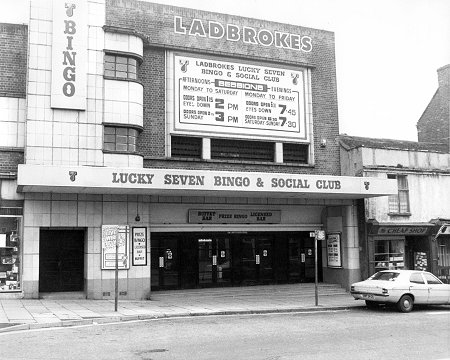
The old Gaumont Cinema. |
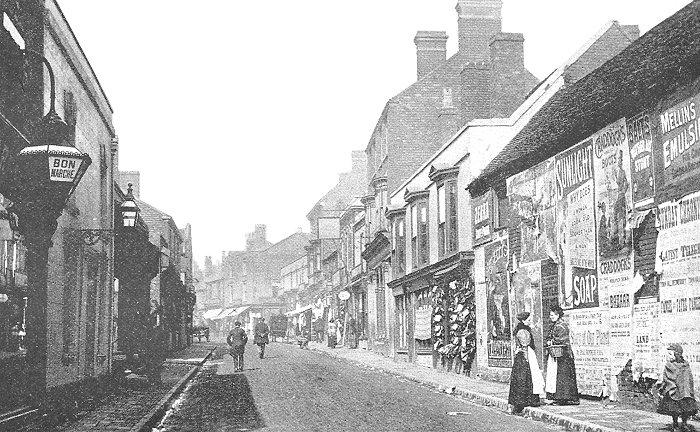
Upper High Street.
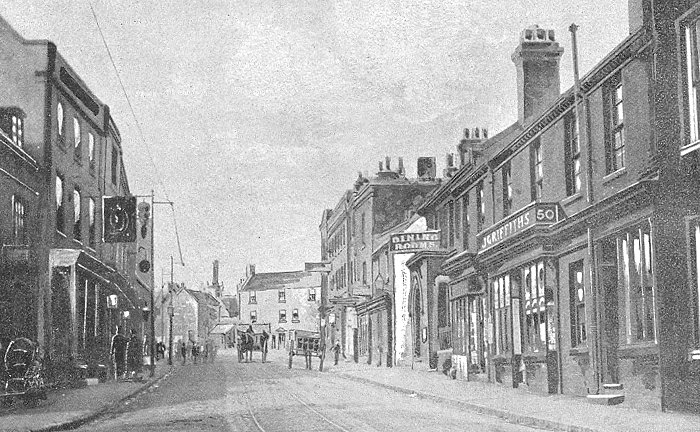
Lower High Street.
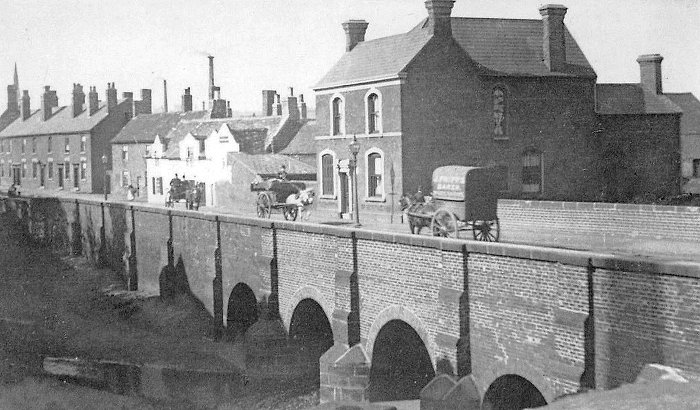
Bridge Street and the bridge over the River
Tame.
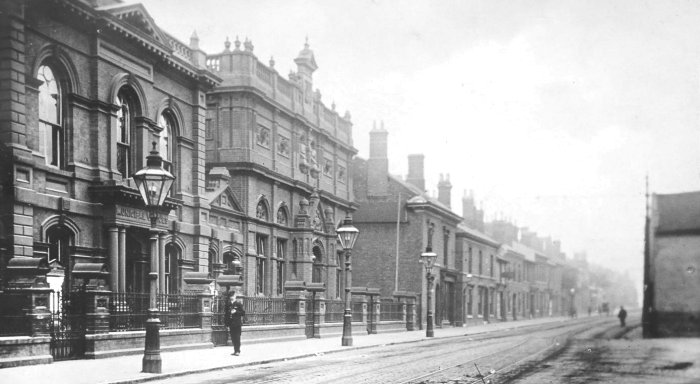
The Town Hall and Art Gallery. From an old
postcard.
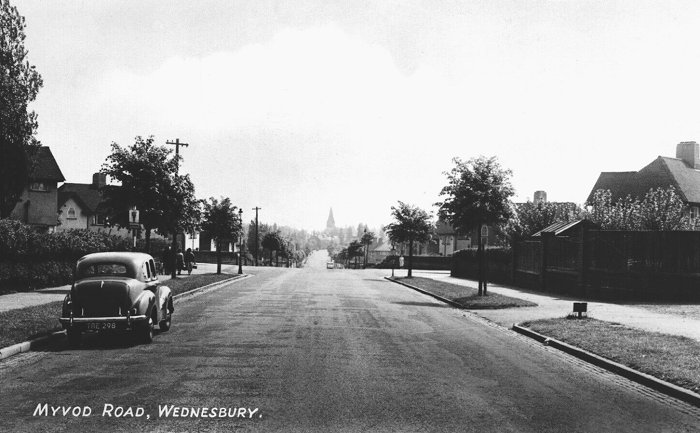
From an old postcard.
 |
|
 |
|
 |
Return to
Pubs |
|
Return to
the contents |
|
Proceed to
World War 1 |
|